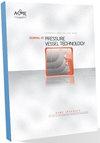Microstructure Analysis And Fe Modelling For Creep Failure Prediction And Fitness-For-Service Assessment Of Superheater Tubes
IF 1.4
4区 工程技术
Q4 ENGINEERING, MECHANICAL
Journal of Pressure Vessel Technology-Transactions of the Asme
Pub Date : 2023-07-20
DOI:10.1115/1.4062974
引用次数: 0
Abstract
This study aimed to perform a Fitness-For-Service (FFS) Assessment and investigate the root cause of failure of Grade 14CrMo3 steel seamless tubes typically used in superheaters in power generation plants. Thickness and hardness measurements were taken from the samples, and microstructural analyses were performed using scanning electron microscopy and X-ray diffraction. The results showed the presence of vanadium (V) and sulfur (S) elements on the tubes' external surface (fireside) which is indicative of fuel ash corrosion. The formation of low melting point salts such as Na2SO4, NaVO3, Na2O, and V2O5 and degradation of the protective oxide layer led to loss of tube wall thickness. On the steam side of the tubes, the formation of an iron oxide layer and the presence of water in the steam due to the improper function of the steam drum created an insulated zone leading to the formation of localized hot spots, creep microvoids, and spheroidization of carbides. In addition, a thickness reduction of 18% resulted in a considerable increase in hoop stresses having a detrimental effect on the remaining creep life. To explain the creep damage mechanism and determine the remaining creep life, the Larson-Miller criteria and API 579-1/ASME FFS-1 guidelines were utilized. The effects of the reduction in wall thickness were considered by performing a 3D finite element analysis. The results showed that a temperature increase of only 50C could decrease the life of the tubes from 30 years to less than a year.过热器管蠕变失效预测及适用性评估的微观结构分析与铁模型
本研究旨在进行适用性(FFS)评估,并调查发电厂过热器中常用的14CrMo3级无缝钢管失效的根本原因。对样品进行厚度和硬度测量,并使用扫描电子显微镜和X射线衍射进行微观结构分析。结果表明,管道外表面(炉边)存在钒(V)和硫(S)元素,这表明燃料灰腐蚀。低熔点盐如Na2SO4、NaVO3、Na2O和V2O5的形成以及保护氧化物层的降解导致管壁厚度的损失。在管道的蒸汽侧,由于汽包功能不当而形成的氧化铁层和蒸汽中存在的水形成了一个绝缘区,导致局部热点、蠕变微孔和碳化物球化的形成。此外,厚度减少18%导致环向应力显著增加,对剩余蠕变寿命产生不利影响。为了解释蠕变损伤机制并确定剩余蠕变寿命,采用了Larson-Miller准则和API 579-1/ASME FFS-1指南。通过进行三维有限元分析,考虑了壁厚减小的影响。结果表明,温度仅升高50摄氏度就可以将管子的寿命从30年缩短到不到一年。
本文章由计算机程序翻译,如有差异,请以英文原文为准。
求助全文
约1分钟内获得全文
求助全文
来源期刊
CiteScore
2.10
自引率
10.00%
发文量
77
审稿时长
4.2 months
期刊介绍:
The Journal of Pressure Vessel Technology is the premier publication for the highest-quality research and interpretive reports on the design, analysis, materials, fabrication, construction, inspection, operation, and failure prevention of pressure vessels, piping, pipelines, power and heating boilers, heat exchangers, reaction vessels, pumps, valves, and other pressure and temperature-bearing components, as well as the nondestructive evaluation of critical components in mechanical engineering applications. Not only does the Journal cover all topics dealing with the design and analysis of pressure vessels, piping, and components, but it also contains discussions of their related codes and standards.
Applicable pressure technology areas of interest include: Dynamic and seismic analysis; Equipment qualification; Fabrication; Welding processes and integrity; Operation of vessels and piping; Fatigue and fracture prediction; Finite and boundary element methods; Fluid-structure interaction; High pressure engineering; Elevated temperature analysis and design; Inelastic analysis; Life extension; Lifeline earthquake engineering; PVP materials and their property databases; NDE; safety and reliability; Verification and qualification of software.

 求助内容:
求助内容: 应助结果提醒方式:
应助结果提醒方式:


